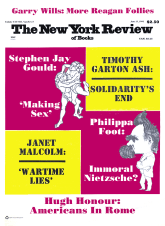In response to:
The Angels and Devils of Dickens from the May 16, 1991 issue
To the Editors:
I am charmed by Garry Wills’s lively review of my Invisible Woman [NYR, May 16], but puzzled by his confident assertion that he knows the name of the “young lady for whom I have a great attachment and regard…innocent and pure, and as good as my own dear daughters,” in the letter of self-exculpation Dickens gave to Arthur Smith, claiming after its appearance in print in America that he had not intended it for publication (the so-called “violated letter”). Wills thinks it was Georgina Hogarth. In fact nobody knows, and I am not alone in thinking it is more likely to have been Nelly Ternan. (A quick check tells me that Johnson leaves the question open, Kaplan assumes it referred to Nelly, the Mackenzies state categorically that it did refer to Nelly; Ackroyd shares Wills’s certainty that it didn’t, but is unable to give a reason for his certainty, or a source.)
One reason for my belief that it is Nelly Dickens means in this penultimate paragraph of his long letter is that Georgina is mentioned by name twice in the earlier parts, and constantly referred to in her capacity as the aunt of Dickens’s children. It seems odd that he should suddenly decide not to mention her name in the later part of the letter. Slightly odd, too, to match her purity and innocence with that of her nieces, to whom she stands as a surrogate mother; whereas they are of an exact age with Nelly.
I think my reading of the dynamics of the situation (to use Wills’s phrase) is as good as his in this respect.
One other point: Wills complains that I make nothing of the obvious comparison between Dickens’s feeling for the Ternans with his feeling for the Hogarths, two families of girls to cherish. It seemed to me far too obvious to labour; and in fact I do draw a comparison between the two families on p. 117, where I say “The Ternans had replaced the Hogarths as worthy objects to be ‘loaded with benefits.’ ” Otherwise I decided to leave readers to notice such comparisons and ironies for themselves; but perhaps I was too elliptical.
Claire Tomalin
London, England
Garry Wills replies:
Tomalin does not get the point of the story she herself tells about Dickens’s first break with Thackeray. Thackeray arrived at his club, the Garrick, where “gossip had it that Georgina [Dickens’s sister-in-law] was the real cause of the trouble [in Dickens’s marriage].” Thackeray, privy to more restricted information, blurted it out, saying, “No…it’s with an actress.” Dickens was furious when he heard of the episode. This tells us a) that the Georgina story was widespread, and b) that Dickens felt resentful when the Nelly story was revealed. Then why would Dickens do himself what he treated as betrayal in Thackeray—when he could deny the more widespread story with righteous indignation, distracting attention from the obscurer scandal? Indeed, to think that he would signal Nelly’s existence in this way makes nonsense of the rest of Tomalin’s book, with all its efforts to hide “the invisible woman.” If the woman in question can be Georgina (as even Tomalin admits), then it has to be Georgina—her purity was the one being vindicated at the time, even with the help of a gynecologist, and discussion of the marriage’s breakup continued to dwell on her until well into this century. Only after modern critics became aware of Nelly, and fascinated by her, did they start, anachronistically, seeing a reference to her where Dickens would never have made one—a point Ackroyd grasps, and one that Tomalin would no doubt grasp, too, if she did not think the relation of the Ternans to the Hogarths too obvious to be given careful attention.
Several correspondants inform me that I confused Thomas Anthony Trollope and Thomas Adolphus—an error of which I am guilty and repentant.
This Issue
June 13, 1991



